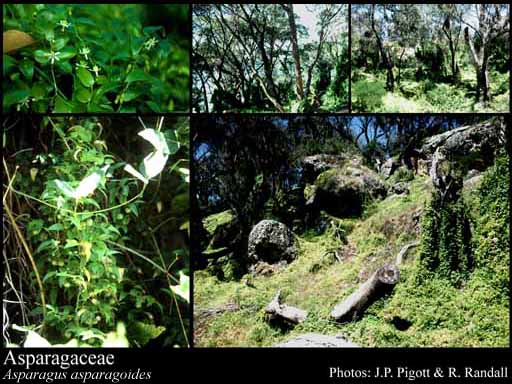- Reference
- Gen.Pl. [Jussieu] 40 (1789)
- Name Status
- Current







Scientific Description
Family Sometimes included in Liliaceae.
Habit and leaf form. Shrubs, or lianas, or herbs, or herbaceous climbers. Switch-plants; with the principal photosynthesizing function transferred to stems (as represented by axillary clusters of cladodes). Leaves much reduced (to small bractlike structures). The herbs perennial; plants with neither basal nor terminal concentrations of leaves; rhizomatous. Self supporting, or climbing; the climbers stem twiners. Twining anticlockwise (Asparagus). Leaves alternate; membranous (scales); more or less sheathing; simple. Leaf blades entire; parallel-veined. Leaves without stipules. Stem anatomy. Secondary thickening absent. Roots. Roots with velamen (often), or without velamen.
Reproductive type, pollination. Fertile flowers hermaphrodite, or functionally male and functionally female, or functionally male, or functionally female, or hermaphrodite, functionally male, and functionally female. Unisexual flowers present, or absent. Plants hermaphrodite, or monoecious, or dioecious, or polygamomonoecious. Female flowers with staminodes.
Inflorescence and flower features. Flowers solitary, or aggregated in ‘inflorescences’; in cymes, or in racemes, or in umbels. The terminal inflorescence unit probably cymose. Inflorescences umbel-like or racemelike, but probably always determinate?. Flowers small; regular; 3 merous; cyclic. Perigone tube present, or absent. Hypogynous disk absent. Perianth of ‘tepals’; 6; 2 -whorled; isomerous; free, or joined; sepaloid, or petaloid; similar in the two whorls; green, or white, or yellow. Androecium present (even in functionally female flowers). Fertile stamens present, or absent (in female flowers). Androecium 6. Androecial members adnate (at the base of the perianth); free of one another; 2 -whorled. Androecium exclusively of fertile stamens (in male and hermaphrodite flowers). Stamens 6; diplostemonous. Filaments appendiculate (spurred at the base), or not appendiculate. Anthers dorsifixed; dehiscing via longitudinal slits; introrse. Fertile gynoecium present, or absent (in male flowers). Gynoecium 3 carpelled. The pistil 3 celled. Carpels isomerous with the perianth. Gynoecium syncarpous; synstylovarious to eu-syncarpous; superior. Ovary plurilocular; 3 locular. Gynoecium stylate. Styles 1; apical; shorter than the ovary at anthesis to about as long as the ovary at anthesis (usually rather short). Stigmas wet type, or dry type. Placentation axile. Ovules 2–12 per locule; non-arillate; hemianatropous, or anatropous, or orthotropous.
Fruit and seed features. Fruit fleshy; indehiscent; a berry. Seeds endospermic. Endosperm oily. Embryo well differentiated. Cotyledons 1. Embryo achlorophyllous (1/1); straight, or curved. Testa encrusted with phytomelan, or without phytomelan. Seedling. Hypocotyl internode present. Mesocotyl absent. Seedling collar not conspicuous. Coleoptile absent. Seedling cataphylls present. Primary root persistent.
Physiology, biochemistry. Photosynthetic pathway: C3.
Geography, cytology, number of species. Holarctic, Paleotropical, Cape, and Australian. World distribution: widespread, especially Old World. About 370 species.
Economic uses, etc. Cultivated ornamentals, and culinary asparagus (A. officinalis).